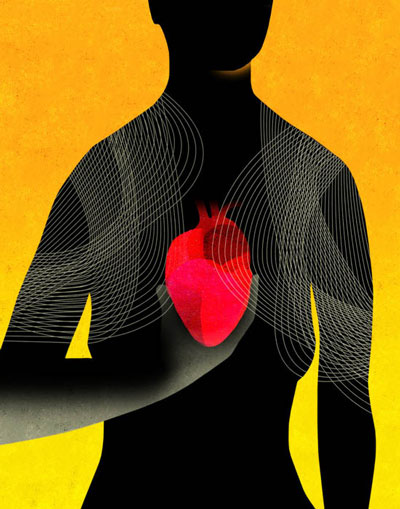The Case of the Fainting Spells

A few months ago, 41-year-old Sarah Mason, of Lithonia, arrived at her daughter’s eighth-grade graduation and parked in the back of the crowded parking lot. She had been having dizzy spells where she would have to lie down to recover—after climbing a hill, going up steps, or running for an elevator at work—but this was the worst one so far.
“I got up the steps and through the door, and I was about to faint,” she says. “I literally stumbled into the front office. It scared everybody. They called the nurse, sat with me, and gave me something to drink.”
Mason was able to make it through the graduation ceremony, but it was the latest in a series of frightening incidents: “I told my husband, ‘It happened again.’ We went to the hospital.” It wasn’t Mason’s first attempt to find out what was wrong. After an earlier fainting spell she had gone to the hospital and had a series of tests, including blood pressure testing while standing up and lying down. The diagnosis was dehydration, and she was given fluids and sent home.
Mason was puzzled. Life was hectic—she is a legal assistant and her husband is a lawyer—but she had always been in great health and exercised regularly. She had been in a car accident the year before and thought that perhaps the symptoms were aftereffects of the accident.
“I noticed that I was becoming more tired,” she says. “When I was walking up steps, my heart would beat as if I had been running. Picking things up was hard. I am a go-go person, so I tried to stay positive.”
After the graduation incident, she went to Kaiser Permanente in Jonesboro. “I do know it’s not good for you to keep fainting like this,” a doctor told her, beginning another set of comprehensive tests.
“They said I was borderline anemic but not too bad,” she says. A heart monitor showed everything was good. The EKG was normal.

What, careful reader, do you believe was causing her dizziness?
The answer came with the last test: an echo-cardiogram. Mason looked at the screen. “I saw this mass, it looked like a big old kidney bean in my left ventricle.
”The imaging had captured a large tumor inside her heart. The Kaiser Permanente cardiologist recognized that he was dealing with an unusual and potentially deadly cause of fainting and immediately referred Mason to Emory cardiac surgeon Douglas Murphy at Emory Saint Joseph’s Hospital.
The findings on the echocardiogram were classic for an atrial myxoma, says Murphy—a benign tumor that can arise in any chamber of the heart. “The tumor on Ms. Mason’s heart had grown so large that in certain positions, it could greatly diminish forward blood flow,” he says.
These tumors are also dangerous because small pieces can break off and enter the bloodstream, causing stroke. “Surgical removal is usually performed urgently,” Murphy says.
Mason was promptly admitted to Emory Saint Joseph’s and, on June 6, underwent an endoscopic robotic removal of the tumor, which was the size of a small potato and located in front of the mitral valve. It was taken out through five small incisions in the right side of her chest.
Murphy and his colleagues have removed more than 200 cardiac tumors using robotics over the last 16 years. Such surgery is less invasive than traditional surgery, with a shorter recovery time.
“Surgery went very well, and Ms. Mason went home after three days,” Murphy says.
Mason is going through cardiac rehabilitation and says she has some residual pain but is feeling a lot better. “Every week, I’m able to tell a difference, even if it’s just little things,” she says. “I have more energy and can walk longer.”
She’s looking forward to returning to an active life where she can once again hurry across a room or climb stairs without a second thought.
To support the division of cardiothoracic surgery, contact jason.zwang@emory.edu or by calling 404-727-2512
Related Stories
Emory Healthcare surgeons lead worldwide training in cardiac robotics (3/6/2018)
Murphy receives highest physician honor from Emory Saint Joseph's Hospital (6/1/2017)





